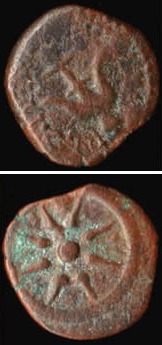Widow's Mite Cross
Alternatively, it may be a penny, a nickel, or some other low value coin. The purpose is to remind us of the importance of humility.
A couple of thousand years ago, a small crowd of people gathered at a temple to make their regular monetary offering. They tossed their contributions into the big treasury box for the poor (or whatever it was actually spent on) and went away, no doubt feeling smug about their good deed for the destitute.
Then an old widow shuffled along. She had no income and little more than two pennies to rub together. Yet despite her indigence, the widow placed two mites in the treasury box. She went away, no doubt feeling hungry. She had done all she possibly could for the destitute.
The mite (or lepton) was the smallest denomination at the time and almost worthless. A loaf of bread might have cost ten prutot in those days, and one prutah was worth about two lepta. In other words, her donation could have bought a slice of bread. But that was all she had, and she gave it willingly.
The Widow Mite's Cross reminds us of Jesus' words about the generous widow. He watched the rich putting their gifts into the treasury, and a poor widow donating two bronze coins. He said, "Truly I tell you, this poor widow has put in more than all the others; they gave from their surplus, but she put in all that she had to live on." (Mark 12:41-44, Luke 21:1-4)
She gave her mite to show her might.
Paradoxically, a Widow Mite's Cross is often made from precious metal and encrusted with gemstones. Why do we feel the need to spend huge sums of money at jewellery stores, to remind ourselves of the importance of humility?
This story may be the origin of the English idiom for poverty: 'only having two pennies to rub together'.

